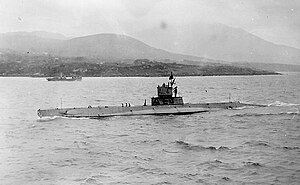USS L-4
 L-4 underway off Berehaven, Ireland
| |
| History | |
|---|---|
| Name | USS L-4 |
| Builder | Fore River Shipbuilding Company, Quincy, Massachusetts |
| Laid down | 23 March 1914 |
| Launched | 3 April 1915 |
| Commissioned | 4 May 1916 |
| Decommissioned | 14 April 1922 |
| Fate | Sold for scrapping, 31 July 1922 |
| General characteristics | |
| Class and type | L-class submarine |
| Displacement |
|
| Length | 168 ft 6 in (51.36 m) |
| Beam | 17 ft 5 in (5.31 m) |
| Draft | 13 ft 7 in (4.14 m) |
| Installed power |
|
| Propulsion |
|
| Speed |
|
| Range |
|
| Test depth | 200 feet (61.0 m) |
| Complement | 28 officers and enlisted men |
| Armament |
|
USS L-4 (SS-43) was an L-class submarine of the United States Navy.
Description
The L-class boats designed by
For surface running, the Electric Boat submarines were powered by two 450-
The boats were armed with four
Construction and career
L-4's
Service history
Assigned to the Atlantic Submarine Flotilla, L-4 operated along the Atlantic coast, assisting in the development of new techniques in undersea warfare until April 1917.
Following the declaration of war on the
Based at Berehaven for the rest of the war, U.S. submarines protected Allied shipping from U-boat attacks. Following the
For the next two years, the submarine operated along the East Coast performing experiments developing the tactics of undersea warfare. L-4 decommissioned at Philadelphia on 14 April 1922 and was sold to Pottstown Steel Company in Douglassville, Pennsylvania, on 31 July 1922 for scrapping.
Notes
References
- Friedman, Norman (1995). U.S. Submarines Through 1945: An Illustrated Design History. Annapolis, Maryland: Naval Institute Press. ISBN 1-55750-263-3.
- Gardiner, Robert & Gray, Randal, eds. (1985). Conway's All the World's Fighting Ships 1906–1921. Annapolis, Maryland: Naval Institute Press. ISBN 0-85177-245-5.
- This article incorporates text from the public domain Dictionary of American Naval Fighting Ships. The entry can be found here.
External links
- Photo gallery of USS L-4 at NavSource Naval History
